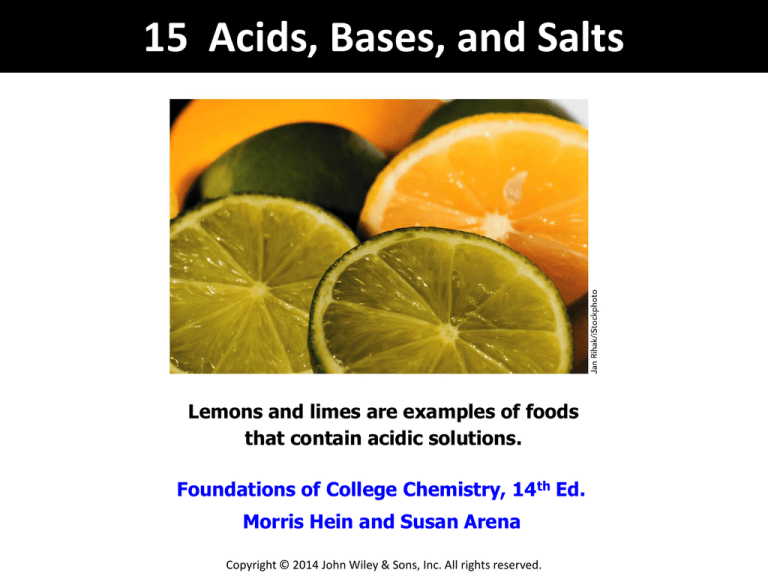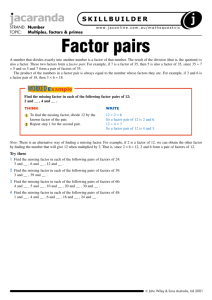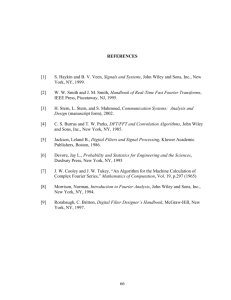
15 Acids, Bases, and Salts
Lemons and limes are examples of foods
that contain acidic solutions.
Foundations of College Chemistry, 14th Ed.
Morris Hein and Susan Arena
Copyright © 2014 John Wiley & Sons, Inc. All rights reserved.
Chapter Outline
15.1
Acids and Bases
15.2
Reactions of Acids and Bases
15.3
Salts
15.4
Electrolytes and Nonelectrolytes
15.5
Introduction to pH
15.6
Neutralization
15.7
Writing Net Ionic Equations
15.8
Acid Rain
© 2014 John Wiley & Sons, Inc. All rights reserved.
Arrhenius Acids
Arrhenius Acid: An acid solution contains
an excess of H+ ions.
Common Properties of Acids
1. Sour taste
2. Turns litmus paper pink
3. Reacts with:
Metals to produce H2 gas
Bases to yield water and a salt
Carbonates to give carbon dioxide
© 2014 John Wiley & Sons, Inc. All rights reserved.
Arrhenius Bases
Arrhenius Bases: A basic solution contains
an excess of OH– ions.
Common Properties of Bases
1. Bitter/caustic taste
2. Turns litmus paper blue
3. Slippery, soapy texture
4. Neutralizes acids
© 2014 John Wiley & Sons, Inc. All rights reserved.
Brønsted-Lowry Acids and Bases
A Brønsted-Lowry acid is a proton (H+) donor.
A Brønsted-Lowry base is a proton (H+) acceptor.
HCl (g) + H2O (l)
Acid
Base
2 H3O+ (aq) + Cl- (aq)
Hydronium ion (hydrated H+)
Conjugate Acid/Base Pairs: Two species that differ
from each other by the presence of one hydrogen ion.
conjugate pair 2
HCO3- (aq) + H2O (l)
Base
Acid
H2CO3 (aq) + OH- (aq)
Conjugate Conjugate
Acid
Base
conjugate pair 1
© 2014 John Wiley & Sons, Inc. All rights reserved.
Brønsted-Lowry Acids and Bases
Identify the base in the following reaction
and the compound’s conjugate acid.
H2PO4- (aq) + H2O (l)
HPO42- (aq) + H3O+ (aq)
Base
Conjugate Acid
a. H2PO4- (aq)
a. H2PO4- (aq)
b. H2O (l)
b. H2O (l)
c. HPO42- (aq)
c. HPO42- (aq)
d. H3O+ (aq)
d. H3O+ (aq)
© 2014 John Wiley & Sons, Inc. All rights reserved.
Lewis Acid-Bases
Lewis Acid: electron pair acceptor.
Lewis Base: electron pair donor.
© 2014 John Wiley & Sons, Inc. All rights reserved.
Summary of the Acid/Base Theories
The theory that best explains the reaction
of interest is used.
© 2014 John Wiley & Sons, Inc. All rights reserved.
Reactions of Acids
1. Reactivity with Metals
Acids react with any metals above
hydrogen in the activity series.
2 HCl (aq) + Mg (s)
MgCl2 (s) + H2 (g)
In general:
acid + metal
salt + hydrogen
2. Reactivity with Bases
Also called a neutralization reaction.
2 HCl (aq) + Ca(OH)2 (aq)
CaCl2 (aq) + 2 H2O (l)
In general:
acid + base
salt + water
© 2014 John Wiley & Sons, Inc. All rights reserved.
Reactions of Acids
3. Reactivity with Metal Oxides
2 HCl (aq) + Na2O (s)
2 NaCl (aq) + H2O (l)
In general:
acid + metal oxide
salt + water
(base)
4. Reactivity with Metal Carbonates
2 HCl (aq) + Na2CO3 (aq)
2 NaCl (aq) + H2O (l) + CO2 (g)
In general:
acid + carbonate
(base)
salt + water + carbon dioxide
© 2014 John Wiley & Sons, Inc. All rights reserved.
Base Reactions
Bases can be amphoteric
(act as either Brönsted acids or bases)
As a base:
Zn(OH)2 (aq) + 2 HBr (aq)
ZnBr2 (aq) + 2 H2O (l)
As an acid:
Zn(OH)2 (aq) + 2 NaOH (aq)
Na2Zn(OH)4 (aq)
NaOH and KOH can also react with metals.
2 NaOH (aq) + 2 Al (s) + 6 H2O (l)
2 NaAl(OH)4 (aq) + 3 H2 (g)
In general:
base + metal + water
salt + hydrogen
© 2014 John Wiley & Sons, Inc. All rights reserved.
Salts
Salts: products from acid-base reactions.
HCl (aq) + NaOH (aq)
NaCl (aq) + H2O (l)
Sodium chloride
(table salt)
Salts are ionic compounds.
Salts contain a cation (a metal or ammonium ion)
derived from the base and an anion
(excluding oxide or hydroxide ions) derived from the acid.
Salts are generally crystalline compounds with
high melting and boiling points.
© 2014 John Wiley & Sons, Inc. All rights reserved.
Salts Practice
Which salt forms in the reaction of
aluminum oxide and hydrobromic acid?
3 Al2O3 (s) + 18 HBr (aq)
6 AlBr3 (aq) + 9 H2O (l)
a. AlBr
b. AlBr3
c. Al2Br
d. Al2Br3
© 2014 John Wiley & Sons, Inc. All rights reserved.
Electrolytes and Nonelectrolytes
Electrolytes: compounds that conduct electricity
when dissolved in water.
Nonelectrolytes: substances that do not conduct
electricity when dissolved in water.
Comparing Solution Conductivity
(Distilled water)
(Sugar solution)
(Salt solution)
© 2014 John Wiley & Sons, Inc. All rights reserved.
Electrolytes and Nonelectrolytes
Ion movement causes conduction of electricity in water.
3 classes of compounds, acids, bases, and salts
are electrolytes because they produce ions
in water when they dissolve.
© 2014 John Wiley & Sons, Inc. All rights reserved.
Electrolytes and Nonelectrolytes Practice
Which compound will not dissociate in water?
a. HCl
a. HCl (acid, dissociates)
b. KBr
b. KBr (salt, dissociates)
c. NaOH
c. NaOH (base, dissociates)
d. CH3OH
d. CH3OH (organic, does not dissociate)
© 2014 John Wiley & Sons, Inc. All rights reserved.
Dissociation of Electrolytes
Salts dissociate into their respective cations
and anions when dissolved in water.
NaCl (s)
Na+ (aq) + Cl- (aq)
Hydrated sodium (purple) and chloride (green) ions
The negative end of
the water dipole is
attracted to the
positive Na+ ion.
When NaCl dissolves in water,
each ion is surrounded by several water molecules.
The permanent dipoles in the water molecules cause
specific alignment around the ions.
© 2014 John Wiley & Sons, Inc. All rights reserved.
Electrolyte Ionization
Ionization: process of ion formation in solution.
Ionization results from the chemical reaction
between a compound and water.
Acids ionize in water, producing the
hydronium ion (H3O+) and a counter anion.
HCl (g) + H2O (l)
H3PO4 (aq) + H2O (l)
H3O+ (aq) + Cl- (aq)
H2PO4- (aq) + H3O+ (aq)
Bases ionize in water, producing the
hydroxide ion (OH-) and a counter cation.
NH3 (aq) + H2O (l)
OH- (aq) + NH4+ (aq)
© 2014 John Wiley & Sons, Inc. All rights reserved.
Strong and Weak Electrolytes
Strong electrolytes: undergo complete ionization in water.
Example: HCl (strong acid)
Weak electrolytes: undergo incomplete ionization in water.
Example: CH3COOH (weak acid)
HCl (left) is 100% ionized.
CH3COOH exists primarily in the unionized form.
© 2014 John Wiley & Sons, Inc. All rights reserved.
Strong and Weak Electrolytes
Double arrows indicate incomplete ionization
(typically weak electrolytes).
HF (aq) + H2O (l)
F- (aq) + H3O+ (aq)
© 2014 John Wiley & Sons, Inc. All rights reserved.
Salts
Salts can dissociate into more than 2 ions,
depending upon the compound.
A 1 M solution of NaCl produces a total of 2 M of ions.
NaCl (s)
1M
Na+ (aq) + Cl- (aq)
1M
1M
A 1 M solution of CaCl2 produces a total of 3 M of ions.
CaCl2 (s)
1M
Ca2+ (aq) + 2 Cl- (aq)
1M
2M
© 2014 John Wiley & Sons, Inc. All rights reserved.
Salts Practice
What is the concentration of bromide ion in a
1.5 M solution of magnesium bromide?
a. 0.75M
b. 1.5M
c. 3.0M
d. 4.5M
For every one mole of MgBr2, 2 moles of Br- ionize.
MgBr2 (s)
1.5 M
Mg2+ (aq) + 2 Br- (aq)
1.5M
3.0M
© 2014 John Wiley & Sons, Inc. All rights reserved.
Colligative Properties
of Electrolyte Solutions
Colligative properties: depend only on the number of
moles of dissolved particles present.
This must be taken into consideration when calculating
freezing point depression or boiling point elevation
due to the presence of solute particles.
Example:
What is the boiling point elevation of a 1.5 m aqueous
solution of CaCl2? (Kb for water is 0.512 ºC/m).
Because CaCl2 is a strong electrolyte, 3 mol of ions (1 mol
Ca2+ and 2 mol Cl- ions) will be present in the solution.
ΔTb = 1.5 m CaCl2 ×
3 mol ions
0.512 ºC
= 2.3 ºC
×
1 mol CaCl2
1m
© 2014 John Wiley & Sons, Inc. All rights reserved.
Colligative Properties
of Electrolytes Practice
What is the boiling point of a 2.0 m aqueous solution
of NaCl? (Kb for water = 0.512 ºC/m)
a. 101.02 ºC
b. 1.02 ºC
c. 2.05 ºC
Because NaCl is a strong electrolyte,
2 mol of ions (1 mol Na+ and 1 mol Cl- ions)
will be present in the solution.
d. 102.05 ºC
ΔTb = 2.0 m NaCl ×
2 mol ions
0.512 ºC
×
1 mol NaCl
1m
Tb = 100.0 ºC + 2.05 ºC = 102.05 ºC
© 2014 John Wiley & Sons, Inc. All rights reserved.
= 2.05 ºC
Autoionization of Water
Pure water auto(self) ionizes according to the reaction:
H2O (l) + H2O (l)
H3O+ (aq) + OH– (aq)
Based on the reaction stoichiometry:
Concentration H3O+ = Concentration OH– = 1 x 10–7 M
[H3O+] x [OH–] = (1 x 10–7)2 = 1 x 10–14
When acid or base is present in water,
[H3O+] and [OH-] change.
In acidic solutions, [H3O+] > [OH–].
In basic solutions, [H3O+] < [OH–].
© 2014 John Wiley & Sons, Inc. All rights reserved.
Introduction to pH
pH = - log[H3O+]
In pure water, [H3O+] = 1 x 10-7 M, so
pH = - log(1 x 10-7) = 7
Neutral
High H3O+
Low OH-
Increasing acidity
Increasing basicity
The pH scale
© 2014 John Wiley & Sons, Inc. All rights reserved.
Low H3O+
High OH-
pH
© 2014 John Wiley & Sons, Inc. All rights reserved.
pH Practice
By what factor is a solution of pH = 3 more acidic
than a solution with a pH = 5?
a. 2
b. 20
pH = 5 means [H3O+] = 1 x 10-5 M
pH = 3 means [H3O+] = 1 x 10-3 M
c. 200
d. 100
Factor =
1 x 10-3 M
= 100
-5
1 x 10 M
© 2014 John Wiley & Sons, Inc. All rights reserved.
pH Calculations
pH = - log[H3O+]
[H3O+] = 10-pH
Generalizations
[H3
O+]
=1x
10-5
M
If exactly 1
[H3O+] = 2 x 10-5 M
If a number between 1 and 10
© 2014 John Wiley & Sons, Inc. All rights reserved.
Exponent = pH
pH = 5
The pH is between
the exponent and
next lowest whole
number
pH = 4.7
pH Calculations
Calculate the pH of a 0.015 M [H3O+] solution.
pH = - log(0.015) = 1.8
Note: the digits to the left of the decimal place in the
pH reflect the power of ten from the [H3O+].
The number of decimal places for the mantissa must equal
the number of significant figures in the original number.
© 2014 John Wiley & Sons, Inc. All rights reserved.
pH Calculations Practice
What is the pH of a 0.020 M HCl solution?
a. 0.020
b. -2.0
c. 1.70
pH = - log(0.020) = 1.7
d. 1.7
© 2014 John Wiley & Sons, Inc. All rights reserved.
pH Calculations Practice
What is the pH of a NaOH solution with a
[OH-] = 2.5 x 10-11 M?
a. 3.4
b. 10.6
[H3O+] x [OH-] = 1 x 10-14
[H3O+] = 1 x 10-14/[OH-]
c. -3.4
= 1 x 10-14/2.5 x 10-11
d. -10.6
= 4.0 x 10-4 M
pH = - log(4.0 x 10-4) = 3.4
© 2014 John Wiley & Sons, Inc. All rights reserved.
Neutralization
General Reaction
acid + base
salt + water
Example
HCl (aq) + NaOH (aq)
NaCl (aq) + H2O (l)
Overall Ionic Equation:
H+(aq) + Cl- (aq) + Na+ (aq) + OH- (aq)
Na+ (aq) + Cl- (aq) + H2O (l)
All species are included; soluble compounds shown as ions.
Net Ionic Equation:
H+ (aq) + OH- (aq)
H2O (l)
Spectator ions (green) are removed from both sides.
© 2014 John Wiley & Sons, Inc. All rights reserved.
Titration
Titration: experiment where the volume of one reagent
(titrant) required to react with a measured amount
of another reagent is measured.
Titrations allow the amount of an acid or base
present in a sample to be determined.
Indicators are used to signal the endpoint of a titration,
the point when enough titrant is added to react
with the acid/base present.
Burets deliver measured amounts of the titrant
into a solution of the unknown reagent.
Endpoint
© 2014 John Wiley & Sons, Inc. All rights reserved.
Titration Calculations
If 22.59 mL of 0.1096 M HCl is used to titrate 25.00 mL
of NaOH, what is the molarity of the base?
Reaction
HCl (aq) + NaOH (aq)
Knowns
NaCl (aq) + H2O (l)
22.59 mL of 0.1096 M HCl
25.00 mL NaOH
Solving for
Molarity of base
Calculate
22.59 mL ×
0.1096 mol HCl
1 mol NaOH
×
= 0.002476 mol NaOH
1 mol HCl
1000 mL soln
Molarity NaOH =
0.002476 mol NaOH
= 0.09903 M NaOH
0.02500 L soln
© 2014 John Wiley & Sons, Inc. All rights reserved.
Titration Calculations
What is the molarity of a NaOH solution if 21.93 mL of
base is required to titrate 0.243 g of oxalic acid (H2C2O4)?
Reaction
H2C2O4 (aq) + 2 NaOH (aq)
Knowns
0.243 g H2C2O4
21.93 mL NaOH
NaC2O4 (aq) + 2 H2O (l)
Solving for
Molarity of base
Calculate
1 mol H2C2O4 2 mol NaOH
=0.005398 mol NaOH
×
0.243 g H2C2O4×
90.04 g H2C2O4 1 mol H2C2O4
0.005398 mol NaOH
= 0.246 M NaOH
0.02193 L soln
Always check reaction stoichiometry!
Molarity NaOH =
© 2014 John Wiley & Sons, Inc. All rights reserved.
Titration Calculations Practice
What is the concentration of a nitric acid solution
if 10.0 mL of the solution is neutralized by
3.6 mL of 0.20 M NaOH?
Reaction
a. 0.072 M
HNO3(aq)+NaOH(aq)
NaNO3(aq)+2 H2O(l)
b. 53.6 M Knowns
3.60 mL, 0.20 M NaOH
c. 0.56 M
10.00 mL HNO3
d. 5.6 M
Calculate
Solving for Molarity of acid
0.20 mol NaOH 1 mol HNO3
= 0.00072 mol HNO3
3.60 mL NaOH×
×
1000 mL NaOH 1 mol NaOH
0.00072 mol HNO3
Molarity HNO3 =
= 0.072 M HNO3
0.01000 L soln
© 2014 John Wiley & Sons, Inc. All rights reserved.
Acid Rain
Acid rain: atmospheric precipitation
more acidic than typical.
General Process for Acid Rain Formation:
1. Emission of nitrogen or sulfur oxides.
2. Transportation of these chemicals throughout
the atmosphere.
3. Chemical reaction of the oxides with water.
This forms sulfuric and nitric acids.
4. Precipitation carries the acids to the ground.
© 2014 John Wiley & Sons, Inc. All rights reserved.
Learning Objectives
15.1 Acids and Bases
Compare the definitions of acids and bases, including
Arrhenius, Brønsted-Lowry, and Lewis acids/bases.
15.2 Reactions of Acids and Bases
Describe the general reactions of acids and bases.
15.3 Salts
Explain how a salt is formed and predict the formula
of a salt given an acid and base precursor.
© 2014 John Wiley & Sons, Inc. All rights reserved.
Learning Objectives
15.4 Electrolytes and Nonelectrolytes
Describe properties, ionization, dissociation, and strength
of electrolytes and compare them to nonelectrolytes.
15.5 Introduction to pH
Calculate the pH of a solution from the
hydrogen ion concentration.
15.6 Neutralization
Describe a neutralization reaction and
do calculations involving titrations.
© 2014 John Wiley & Sons, Inc. All rights reserved.




